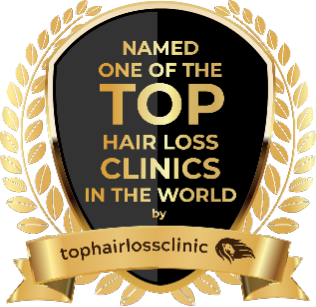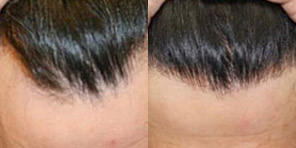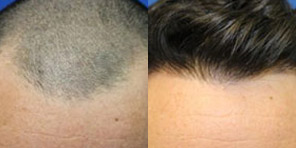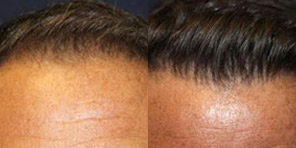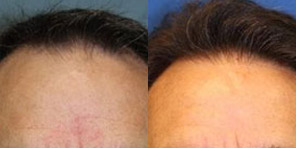Hair Restoration Method
At California Hair MD, we pride ourselves in offering hair restoration services that are a cut above the rest. We believe in doing everything we can to meet our patients’ aesthetic goals. This means we treat our patients on an individual basis, because there is no “one size fits all” hair loss or hair replacement solution, each has unique needs and requirements that have to be considered. Superior hair restoration is not just due to advanced surgical or aesthetic methods and technologies, it is also determined by the caliber of the expert wielding the instruments. Their approach towards how they treat their patients will make all the difference.
This is why I wanted to mention our philosophy regarding hair restoration and how it differs significantly from other practices. Here are some of my thoughts below:
1. Most hair restoration practices quote patients a fee based upon a certain dollar amount per graft.
2. This is really a counterintuitive method for several reasons.
3. Every hair restoration practice a patient visits gives a different estimate of the number of grafts the patient will need. That is because it is an estimate, at best, and inaccurate at worst.
4. There are too many variables to accurately determine the number of grafts a patient needs just from a consultation, even an in-person one. One reason is your hair structure: what is the follicular count (ie, how many “hairs” do you have per follicle?)? Sometimes that is only assessed during the actual follicle extraction process where we can most accurately examine each follicle extracted and see it is a “one” (one hair per follicle), a “two” (two hairs per follicle), and so on…Second, what is the quality of your donor area? Is your hair fine, coarse, straight, curly? This will also help to determine your “coverage”. Third, how large an area needs coverage? Frontal, mid-scalp, crown? What is the size of your skull (larger areas or wider skulls require more grafts)? All of these variables create inaccuracy and uncertainty in quoting a hair transplant procedure based upon numbers of grafts.
5. How does the practice actually quote this to a prospective patient? If you have several “hairs” per follicular unit then do they quote you based upon each individual hair or individual follicle? This is quite a difference in costs.
6. How do you really know how many grafts were extracted and actually implanted at the time of your procedure? Did the practice take multiple hair follicles and split them into single hairs to reach the number you were quoted? As you can see, there is a lot of uncertainty and potential for dishonesty.
7. For example, my follicles are mostly “ones”. If someone else who has a higher follicular count and I both went to the same transplant surgeon for an estimate and got a quote for 1000 or 2000 grafts who do you think would get the better result? It wouldn’t be me; it would be the person with the higher follicular count. Somehow, that doesn’t seem fair. Why should a patient’s outcome and his cost for a procedure be “penalized” by his anatomy-something he really has no control over in the first place?
8. Most hair restoration practices present hair transplant surgery as a “commodity”, just like buying a pair of sunglasses. Wherever you buy a Ray-Ban pair of sunglasses, they are still a Ray-Ban regardless of the cost. However, not every hair transplant procedure is “Ray-Ban” quality! This is not a commodity, it is a surgical procedure. And, it is permanent! If you don’t like your pair of sunglasses then you can always return them for a refund. The same doesn’t apply to a hair transplant procedure. Revising a poorly designed and executed hair transplant can be challenging and not always successful. In the end, it is not about cost but about quality. I doubt someone will remember a few years from now that he spent a little more money when he looks in the mirror and is thrilled with the result, year after year.
9. Hair Transplant Surgery is Plastic Surgery. So, who is most qualified to perform it? Right, a Board-Certified Plastic Surgeon. Plastic surgeons are trained in all aspects of face, hair, and scalp surgery. The American Board of Plastic Surgery is the only ABMS board that certifies surgeons in cosmetic of the face and body, which includes hair restoration surgery. To become a Board-Certified Plastic Surgeon requires nearly a decade of surgical training and clinical experience following medical school.
10. My approach to every patient who suffers from hair loss and requires hair restoration is simple: we will place as many hairs on your head as possible with the procedure and make it as dense as possible. In reality, hair transplantation is rarely a need for an even number like 1200 grafts. It’s more like 1250 or maybe 1255. When patients are quoted for a procedure based upon an arbitrary number of grafts, then what happens if they need more grafts at the time of transplantation? You guessed it, they are asked to pay more money than they expected or perhaps budgeted for in the first place. So, instead of quoting a patient based upon a dollar amount per graft, I prefer quoting a flat rate for as many grafts as we need and can fit in an area.
11. For example, when a hair transplant practice tells you they are going to transplant 1000 hairs what are they really telling you? Hairs often grow out of the scalp in groups of hairs, not just one. If they remove groups at the time of the procedure are they splitting them and charging for each hair? In other words, are they actually harvesting 700 to 800 grafts and simply splitting 200 to reach the target of 1000 grafts. Now you can see the potential for corruption in such a process.
12. Our practice has a unique and much more transparent and ethical manner to quote a fee for a hair transplant procedure. We quote a flat rate based upon the area we are treating and promise to fit in as many hairs as possible into that area to get the most density possible in a safe manner.
13. Because we have every type of technology that is currently available in hair restoration, we choose the most ideal combination of treatment devices and techniques to obtain the ultimate aesthetic outcome. If you only have one device then you must “fit” each patient to that technique. The adage of seeing everything as a nail if you only have a hammer seems very pertinent here. Instead, we often combine the best devices available.
14. For example, we have the most current robotic hair restoration device available in the world today. It is called the Artas i-X, the first one in San Diego and Orange Counties. It can harvest grafts faster and more accurately than the best human, within microns of accuracy. It uses 2 cameras built into the robotic arm to pick out the best hair follicles to harvest in the most random pattern possible to prevent thinning of the donor area. In addition, the robotic arm can now even make the sites in the frontal area in which to place the hair transplant grafts and to avoid damaging normal, surrounding hair, even more accurately than any human! The accuracy, precision, and reproducibility of the Artas i-X provide for a superior transplant process.
15. However, there is still much artistry to the procedure. We still utilize a handheld, semi-automatic FUE device like the Neograft machine to harvest single fine hairs for the frontal hairline to create a natural-looking hairline. We also place many of the transplants by hand, especially in the crown area. We call our procedure a Hybrid or Composite hair restoration procedure because it combines the best technologies in the world, the Artas i-X and the Neograft. No one can offer a more sophisticated, state-of-the-art hair restoration than we can offer. We don’t believe in short cuts, neither in training nor in the technology for hair restoration. Our patients deserve the best!
16. Many plastic surgeons have a focus or area of specialization based upon their training, experience, and interest. For example, some plastic surgeons focus on rhinoplasty and become experts in this field, receiving referrals from many of their plastic surgery colleagues. Others might focus on facelifts, breast surgery, or body contouring. Fewer still have a passion and focus for hair restoration; in fact, there is only a handful of us in the country. We are looked upon by our colleagues as experts in this field and are often referred patients for hair loss by many of them. It is an honor to be amongst such great company and a big responsibility at the same time.
These are my thoughts on what sets California Hair MD apart from the rest. We strive to give our patients the quality of treatment they deserve. And this commitment to our patients determines the implementation of our services and procedures. After all, there is no “one size fits all” approach to hair restoration. Hair restoration is not a commodity or product that you can just get from a shelf. It is a deeply personal procedure and the surgeon and hair transplant staff have to be there for the patient at each and every step.
This is our view at California Hair MD, in order to not only meet but exceed our patients’ expectations.

